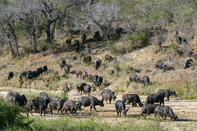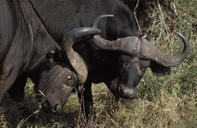Clans and Herds
Buffalo are gregarious and live in mixed herds often numbering hundreds of individuals. These herds may increase or decrease in number seasonally.

The main herd is subdivided into smaller more closely related units or clans of cows and their offspring that cluster and move or rest together. During abundant summer times, the herds will segregate into these smaller units, joining up again when resources are isolated in the dry season.
Cows are arranged within the sub-herds according to rank which improves when they have young calves. Adult bulls are affiliated to and preside over the clans. Within the larger herd, a bull’ status is delineated according to its size and age. When larger herds split, bulls may associate in age-related bachelor groups.
Young bulls only get an opportunity to mate at 7 or 8 years old (in spite of reaching maturity at five). By isolating in bachelor groups these youngsters are able to avoid the ongoing male power struggle within the larger herd for a time.
Rank and Defences

Rank in bull buffalo is a product of their fighting ability which is proportional to age and hence size. Although various forms of posturing generally keeps encounters between males civil, strength contests can quickly be settled through head-on clashes the impact of which is absorbed by the enormous bosses.
The impact of such combat can be likened to a car hitting a brick wall at 50 kmph. The advantage of rank within a herd of buffalo is that more dominant individuals feed ahead of and in the centre of the herd and they do not have to contend with trampled pastures. This privileged position also affords these animals the best protection from predators.
High ranked bulls benefit from better access to oestrus cows. When threatened, buffalo raise the alarm with a distinct distressed bellow to which members of the herd respond as a group. The calves and younger animals are sheltered alongside the cows in the centre of the herd while the adult males defend the flanks and rear.
Since they are such large bulky animals, putting up a united defence front against predators is more effective than trying to flee clumsily.
As a unit, buffalo will mob offending predators or stampede unexpectedly and they are often able to hold their own against even a whole pride of lions. If they do flee, they run at a speed conducive to the herd remaining safely clumped together although an individual buffalo can reach speeds of almost 60 kmph.
By Megan Emmett